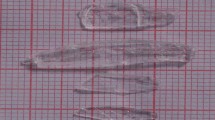Abstract
Chloroquine sulphate, like the phosphate, is an antimalarial formulation widely used in the tropics. The stability of such formulations is therefore of interest in the combat against malaria. A DSC study has been made of the effects of exposure to the sun, heat and UV radiation on the stability of chloroquine sulphate, similarly as performed earlier for chloroquine phosphate. When freshly recrystallized from a water-acetone mixture, chloroquine sulphate exhibits two endothermic peaks, at 169.4° and 204.7°, for the expulsion of crystal water (one molecule) and for the melting process, respectively. The exposure of chloroquine sulphate to the sun, heat and UV radiation leads to splitting of the peak for melting.
Zusammenfassung
Chloroquine-Sulfat ist ebenso wie das entsprechende Phosphatderivat ein in den Tropen weitverbreitet angewandtes Antimalaria-Präparat. Die Stabilität dieses Präparates hat damit Bedeutung für die Malariabekämpfung. Die vorliegende Arbeit ist eine Erweiterung einer Untersuchung über den Effekt der Einwirkung.von Sonne, Hitze und UV-Strahlen auf die Stabilität von Chloroquine-Phosphat auf Chloroquine-Sulfat. Aus Wasser-Aceton-Mischungen frisch kristallisiertes Chloroquine-Sulfat zeigt zwei endotherme Peaks bei 169,4 und 204,7 °C, die durch Abgabe von Kristallwasser (ein Molekül) bzw. durch den Schmelzvorgang bedingt sind. Wird Chloroquine-Sulfat der Sonne, Wärme oder UV-Licht ausgesetzt, so wird der dem Schmelzvorgang zuzuscheibende Peak aufgespalten.
Резюме
Хлорокин сульфат, под обно фосфат-производному, является антималяри йным препаратом, широко ис пользуемым в тропика х. Для успешной борьбы с мал ярией требуется знание устойчивости таких препаратов. В ра боте изучено влияние солн ца, тепла и УФ облучени я на устойчивость хлор окин сульфата. Хлорок ин сульфат, свеже перекристалли зованный из водноацетоновой сме си, показал два эндоте рмических пика при 169,4 и 204,7°, вызванн ых, соответственно, выде лением одной молекул ы воды и процессом плавления. Действие на хлорокин сульфат сол нечного света, тепла и УФ облучения вызывает р асщепление пика плавления.
Similar content being viewed by others
References
C. Mulokozi+, I. Edafiogho, M. Mulokozi and S.Diete-Spiff, (to be published).
A. Burger, Medicinal Chemistry, Part 1, 3rd edn., Wiley-Interscience, London, 1970, pp. 492–521.
J. L. McNaughton and C. T. Mortimer, Differential Scanning Calorimetry, in Int. Review of Science, Phys. Chem. Series 2, Vol. 10: Thermochemistry and Thermodynamics. Vol. Editor H. A. Skinner, Butterworths, London, 1975.
Author information
Authors and Affiliations
Rights and permissions
About this article
Cite this article
Edafiogho, I.O., Mulokozi, G., Mubokozi, A.M. et al. Differential scanning calorimetry of chloroquine sulphate exposed to sun, heat and ultraviolet radiation. Journal of Thermal Analysis 32, 1567–1574 (1987). https://doi.org/10.1007/BF01913357
Received:
Issue Date:
DOI: https://doi.org/10.1007/BF01913357




